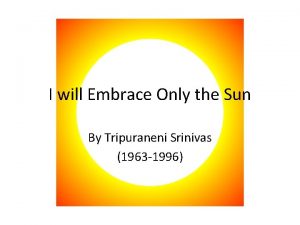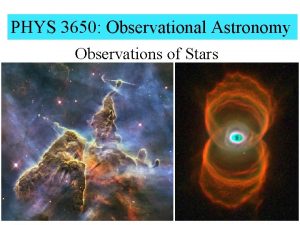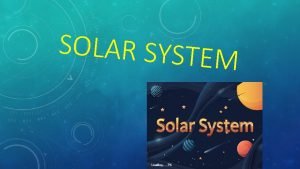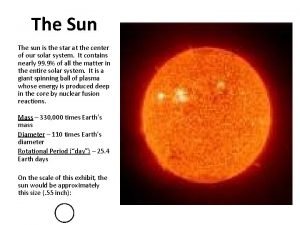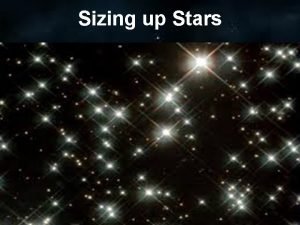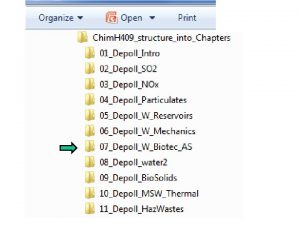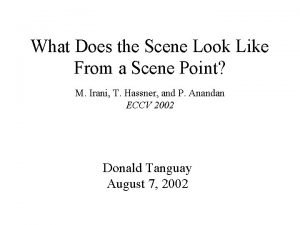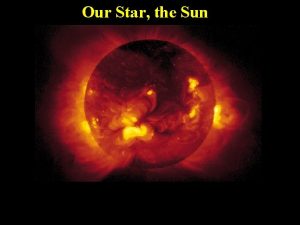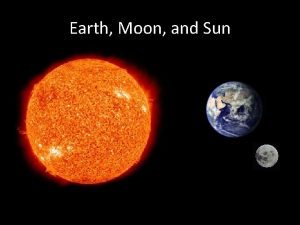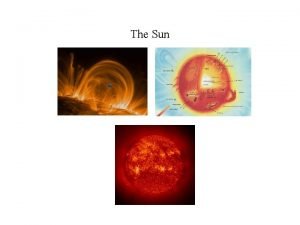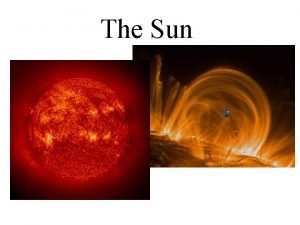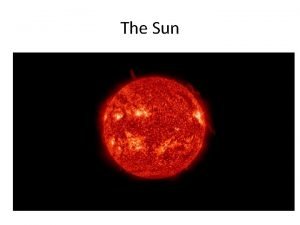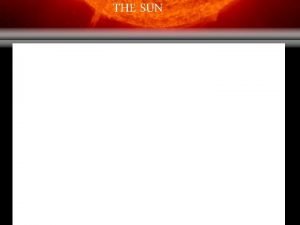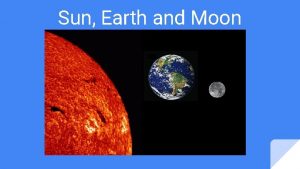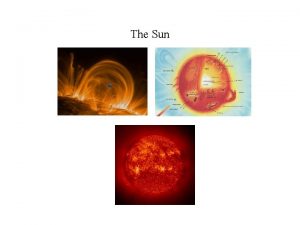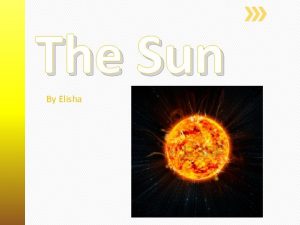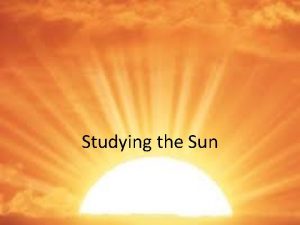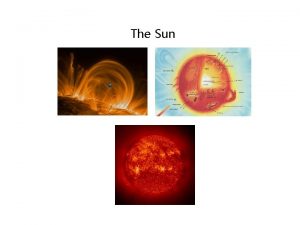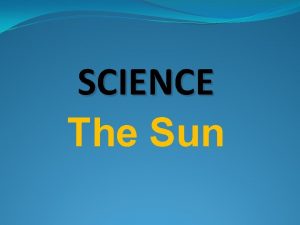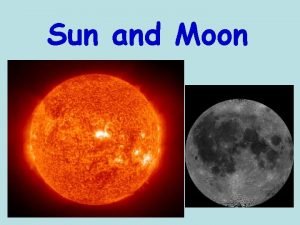The Sun A typical Star The only star
































- Slides: 32

The Sun – A typical Star • • The only star in the solar system Diameter: 100 that of Earth Mass: 300, 000 that of Earth Density: 0. 3 that of Earth (comparable to the Jovians) • Rotation period = 24. 9 days (equator), 29. 8 days (poles) • Temperature of visible surface = 5800 K (about 10, 000º F) • Composition: Mostly hydrogen, 9% helium, traces of other elements Solar Dynamics Observatory Video

How do we know the Sun’s Diameter? • Trickier than you might think • We know only how big it appears – It appears as big as the Moon • Need to measure how far it is away – Kepler’s laws don’t help (only relative distances) • Use two observations of Venus transit in front of Sun – Modern way: bounce radio signal off of Venus

How do we know the Sun’s Mass? • Fairly easy calculation using Newton law of universal gravity • Need to know distance Earth-Sun • General idea: the faster the Earth goes around the Sun, the more gravitational pull the more massive the Sun • Earth takes 1 year to travel 2π (93 million miles) Sun’s Mass = 300, 000 that of Earth

How do we know the Sun’s Density? • Divide the Sun’s mass by its Volume • Volume = 4π × (radius)3 • Conclusion: Since the Sun’s density is so low, it must consist of very light materials

How do we know the Sun’s Temperature? • Use the fact that the Sun is a “blackbody” radiator • It puts out its peak energy in visible light, hence it must be about 6000 K at its surface

Black Body Spectrum • Objects emit radiation of all frequencies, but with different intensities Ipeak Higher Temp. Ipeak Lower Temp. fpeak<fpeak

How do we know the Sun’s composition? • Take a spectrum of the Sun, i. e. let sunlight fall unto a prism • Map out the dark (Fraunhofer) lines in the spectrum • Compare with known lines (“fingerprints”) of the chemical elements • The more pronounced the lines, the more abundant the element

Spectral Lines – Fingerprints of the Elements • Can use spectra to identify elements on distant objects! • Different elements yield different emission spectra

Sun Compare Sun’s spectrum (above) to the fingerprints of the “usual suspects” (right) Hydrogen: B, F Helium: C Sodium: D

“Sun spectrum” is the sum of many elements – some Earth-based!

The Sun’s Spectrum • The Balmer line is very thick lots of Hydrogen on the Sun • How did Helium get its name?

How do we know the Sun’s rotation period? • Crude method: observe sunspots as they travel around the Sun’s globe • More accurate: measure Doppler shift of spectral lines (blueshifted when coming towards us, redshifted when receding). – THE BIGGER THE SHIFT, THE HIGHER THE VELOCITY

Actual Data: Spectra of East and West Limb of the Sun • Note unshifted lines due to Earth’s atmosphere

How do we know how much energy the Sun produces each second? • The Sun’s energy spreads out in all directions • We can measure how much energy we receive on Earth • At a distance of 1 A. U. , each square meter receives 1400 Watts of power (the solar constant) • Multiply by surface of sphere of radius 149. 6 bill. meter (=1 A. U. ) to obtain total power output of the Sun

Energy Output of the Sun • Total power output: 4 1026 Watts • The same as – 100 billion 1 megaton nuclear bombs per second – 4 trillion 100 W light bulbs – $10 quintillion (10 billion) worth of energy per second @ 9¢/k. Wh • The source of virtually all our energy (fossil fuels, wind, waterfalls, …) – Exceptions: nuclear power, geothermal

What process can produce so much power? • For the longest time we did not know • Only in the 1930’s had science advanced to the point where we could answer this question • Needed to develop very advanced physics: quantum mechanics and nuclear physics • Virtually the only process that can do it is nuclear fusion

Nuclear Fusion • Atoms: electrons orbiting nuclei • Chemistry deals only with electron orbits (electron exchange glues atoms together to from molecules) • Nuclear power comes from the nucleus • Nuclei are very small – If electrons would orbit the statehouse on I-270, the nucleus would be a soccer ball in Gov. Kasich’s office – Nuclei: made out of protons (el. positive) and neutrons (neutral)

Nuclear fusion reaction – In essence, 4 hydrogen nuclei combine (fuse) to form a helium nucleus, plus some byproducts (actually, a total of 6 nuclei are involved) – Mass of products is less than the original mass – The missing mass is emitted in the form of energy, according to Einstein’s famous formulas: E= 2 mc (the speed of light is very large, so there is a lot of energy in even a tiny mass)

Hydrogen fuses to Helium Start: 4 + 2 protons End: Helium nucleus + neutrinos Hydrogen fuses to Helium

The Standard Solar Model (SSM) • Sun is a gas ball of hydrogen & helium • Density and temperature increase towards center • Very hot & dense core produces all the energy by hydrogen nuclear fusion • Energy is released in the form of EM radiation and particles (neutrinos) • Energy transport well understood in physics

Standard Solar Model

Hydrostatic Equilibrium • Two forces compete: gravity (inward) and energy pressure due to heat generated (outward) • Stars neither shrink nor expand, they are in hydrostatic equilibrium, i. e. the forces are equally strong Gravity Heat Gravity

More Mass means more Energy • More mass means more gravitational pressure • More pressure means higher density, temperature • Higher density, temp. means faster reactions & more reactions per time • This means more energy is produced

How do we know what happens in the Sun? • We can’t “look” into the Sun • But: come up with theory that explains all the features of the Sun and predicts new things • Do more experiments to test predictions • This lends plausibility to theory

Understanding Stars • “Understanding” in the scientific sense means coming up with a model that describes how they “work”: – Collecting data (Identify the stars) – Analyzing data (Classify the stars) – Building a theory (Explain the classes and their differences) – Making predictions – Testing predictions by more observations

Identifying Stars - Star Names • Some have names that go back to ancient times (e. g. Castor and Pollux, Greek mythology) • Some were named by Arab astronomers (e. g. Aldebaran, Algol, etc. ) • Since the 17 th century we use a scheme that lists stars by constellation – in order of their apparent brightness – labeled alphabetically in Greek alphabet – Alpha Centauri is the brightest star in constellation Centaurus • Some dim stars have names according to their place in a catalogue (e. g. Ross 154)

Classification by Star Properties • What properties can we measure? – distance – velocity – temperature – size – luminosity – chemical composition – mass

Classification of the Stars: Temperature Class O B A F G K M Temperature 30, 000 K 20, 000 K 10, 000 K 8, 000 K 6, 000 K 4, 000 K 3, 000 K Color blue bluish white yellow orange red Examples Rigel Vega, Sirius Canopus Sun, Centauri Arcturus Betelgeuse Mnemotechnique: Oh, Be A Fine Girl/Guy, Kiss Me

The Key Tool to understanding Stars: the Hertzsprung-Russell diagram • Hertzsprung-Russell diagram is luminosity vs. spectral type (or temperature) • To obtain a HR diagram: – get the luminosity. This is your y-coordinate. – Then take the spectral type as your x-coordinate, e. g. K 5 for Aldebaran. First letter is the spectral type: K (one of OBAFGKM), the arab number (5) is like a second digit to the spectral type, so K 0 is very close to G, K 9 is very close to M.

Constructing a HR-Diagram • Example: Aldebaran, spectral type K 5 III, luminosity = 160 times that of the Sun L 1000 160 100 Aldebaran 10 1 Sun (G 2 V) O B A F G K M Type … 0123456789 012345…

The Hertzprung -Russell Diagram • A plot of absolute luminosity (vertical scale) against spectral type or temperature (horizontal scale) • Most stars (90%) lie in a band known as the Main Sequence

Hertzsprung-Russell diagrams … of the closest stars …of the brightest stars
 Bearing gifts we traverse afar
Bearing gifts we traverse afar Leave only footprints take only photos
Leave only footprints take only photos Summary of the poem i will embrace only the sun
Summary of the poem i will embrace only the sun With the stars
With the stars What does the sun made of
What does the sun made of Uranus distance from sun
Uranus distance from sun Sun is a star
Sun is a star Fccla star stands for
Fccla star stands for Differentiate between a* and ao* algorithm
Differentiate between a* and ao* algorithm Drying time calculation
Drying time calculation Why is mrs birling not a typical maternal figure
Why is mrs birling not a typical maternal figure Structure of a bacterium
Structure of a bacterium Teen film genre
Teen film genre Typical scenario
Typical scenario Typical english house
Typical english house Patogenesis hiv
Patogenesis hiv A typical brake pedal position (bpp) sensor/switch is
A typical brake pedal position (bpp) sensor/switch is Peripteral plan
Peripteral plan Camshaft lobe separation
Camshaft lobe separation Typical vs atypical chest pain
Typical vs atypical chest pain English cuisine
English cuisine Typical school day
Typical school day Brahmins typical jobs
Brahmins typical jobs Typical plant cell
Typical plant cell Typical european city
Typical european city What is a stem milady chapter 30
What is a stem milady chapter 30 Typical animal embryos have
Typical animal embryos have Typical composition of untreated domestic wastewater
Typical composition of untreated domestic wastewater Homography
Homography Typical vertebra superior view
Typical vertebra superior view Bogey negotiation
Bogey negotiation Mike acton
Mike acton Holistic technology in human values
Holistic technology in human values


